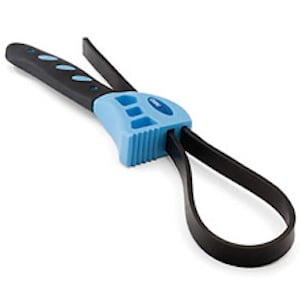Opening a Five-Gallon Jug with a Strap Wrench
Five-gallon jugs of Culinary Solvent are packaged in high-density polyethylene (HDPE) plastic containers with one opening, measuring 3.125" in diameter. In order to ship five-gallon jugs of food grade ethyl alcohol (ethanol) in compliance with Department of Transporation (DOT) regulations, the cap to the jug is closed using a torque wrench to specifications provided by the container manufacturer. Due to the tightness of this seal, we include a free strap wrench with all orders of five-gallon jugs. This page is intended to assist you with understanding why your jug cap is so tight, how to open the jug for the first time, and instructions for closing your jug for storage after opening.
Will I Need to Use the Strap Wrench Every Time I Open my Jug?
You only need use the strap wrench for the first time you are opening the jug. You can reseal the container to just "finger-tight" after breaking the initial torque seal on the cap. There is no benefit to retorquing the cap for storage; this is only required for shipping.

What is a Strap Wrench?
Strap wrenches are adjustable leverage tools that work using the friction of a rubber strap and the jaw and teeth found on common adjustable pipe wrenches. Strap wrenches are perfect for gripping round objects, especially caps and lids that don't offer a flat surface where a traditional wrench can apply torque. Strap wrenches operate differently than traditional wrenches and offer more flexibility in terms of adjustment and grip-potential without leaving marks or scrapes on the surface to be turned. More often than not, you can use a strap wrench wherever you can use a pipe wrench, but you cannot always use a pipe wrench where you would need to use a strap wrench.
How Does Each Type of Wrench Work?
Adjustable Wrenches
Common adjustable wrenches require a smooth, machined surface to grip on to (think of the hexagon shape of a traditional nut and bolt). Once properly fitted, force is multiplied depending on the length of the wrench's handle. The longer the handle of the wrench, the more the force is multiplied, thereby making tightening or loosening easier than just using your fingers.
Pipe Wrenches
Pipe wrenches differ from adjustable wrenches primarily by the presence of teeth on the gripping surface (the jaw). The teeth of a pipe wrench bite into the round object that is being worked on, typically smooth round plumbing pipe. Just like the adjustable wrench described above, once a grip is achieved, the force is multiplied down the length of the handle to provide the desired tightening or loosening effect.
Strap Wrenches
Strap wrenches feature a strap of rubber that adheres to the object to be turned using friction of the rubber. The flexible rubber strap is able to conform to all shapes, including hex nuts, round pipes, smooth jar lids, or bumpy round jug caps. Once a tight grip is achieved via friction, force is again multiplied down the handle and transferred as torque to the object.
Science of the Strap Wrench
Because strap wrenches rely on friction to grip, the motion of turning a strap wrench is slightly different than the motion used for a traditional (adjustable/pipe) wrench. Before turning a traditional wrench, a compatible surface (smooth for an adjustable wrench or soft enough for teeth grip into for a pipe wrench) must be achieved or the wrench will slip. However, the grip of the strap wrench increases as pressure is placed on the handle, so in turning the wrench, the user is simultaneously gripping the object and beginning to apply torque to turn it. When turning a traditional wrench, the axis of motion is focused on the center of the object that is being turned (i.e., axis of motion for a hex nut is the bolt it is attached to). When turning a strap wrench, the user must first pivot the teeth of the handle into the strap. By first applying pressure to the teeth in this pivot motion, the handle of the wrench may be slightly angled and almost feel off center. By continuing to apply constant pressure toward the teeth, the strap will begin to stretch slightly while increasing the grip pressure uniformly around the object to be turned. Eventually, the strap will cease stretching and friction will begin to transfer the rotational force of the wrench handle into torque to twist the object to be turned.
Strap Wrench vs. Adjustable or Pipe Wrench
Adjustable wrenches and pipe wrenches get bigger (and heavier) as their jaw size increases. To obtain a pipe wrench that has a jaw that will open wide enough to fit the 3" cap of our jug, you would need to source a wrench with a handle of 24" or more.
Strap wrenches, on the other hand, can offer the ability to turn large objects using a small, lightweight design.
Steps for Using a Strap Wrench to Open Your Five-Gallon Jug
- Place your five-gallon jug on a table or other flat surface that is about waist high. You will need to be able to grab the jug and wrench at the same time.
- Thread the strap through the slot in the handle of the wrench. You want the loop to be just a little bigger than the jug cap.
- Orient the wrench to loosen the cap. Holding the strap wrench in your hand, the teeth of the wrench should be to the right. Always turn the wrench toward the teeth. The teeth of a strap wrench are designed to bite into the rubber strap, preventing the strap to get bigger and providing a strong grip on the cap thanks to friction. Orientation of the wrench is important; the strap wrench will not work if you turn the wrench away from the teeth.
- Place the loop of the strap wrench over the cap of the five-gallon jug. Pull the lose end of the strap to tighten the loop around the cap snuggly.
- While holding the five-gallon jug with one hand (to prevent the jug from moving while twisting the cap), begin to apply pressure to the strap wrench handle in a counterclockwise motion. Ensure the teeth of the strap wrench are biting into the rubber strap by pivoting the teeth at the top of the handle into the rubber strap. This pivot motion will begin to stretch the rubber strap on the opposite side of the teeth. As the far end of the rubber strap stretches, the strap's grip on the cap is steadily increasing. This pivot-and-stretch motion of the strap is necessary for the wrench to have an adequate grip on the cap.
- Continue to apply constant steady pressure in a counterclockwise motion to the strap wrench handle until the cap's torque is overcome. Gripping the handle as low as possible (furthest away from the cap) will increase your leverage and will be easier. The cap will begin to move slightly as the torque is overcome. Continue applying pressure to the handle until the cap turns freely.









